Last updated: August 18, 2025
Article
50 Nifty Finds #7: The Waugh Factor
Before and during the early years of the National Park Service (NPS), publicity for national parks was spearheaded and funded by railroads, hotel operators, automobile associations, friendly newspaper and magazine editors, and others in the tourism industry. In the 1920s the NPS wrote and published stories and reports about the national parks, but it wasn’t until 1934—National Parks Year—that it began its own program using graphic arts to encourage people to visit national and state parks. NPS employee, artist, and landscape architect Dorothy Waugh designed 17 posters between 1934 and 1936.
A Portrait of the Artist
Dorothy Waugh was born on September 23, 1896, in Burlington, Vermont, to Frank and Alice Waugh. She was one of six children. In 1902 the family moved to Amherst, Massachusetts, when her father took a position as head of the department of horticulture at Massachusetts Agricultural College. He became a professor in landscape architecture at Massachusetts State College. Her mother was a former art critic. In a family of successful and talented children, Dorothy excelled as a writer and illustrator. Her younger brother Sidney became a renowned sculptor.
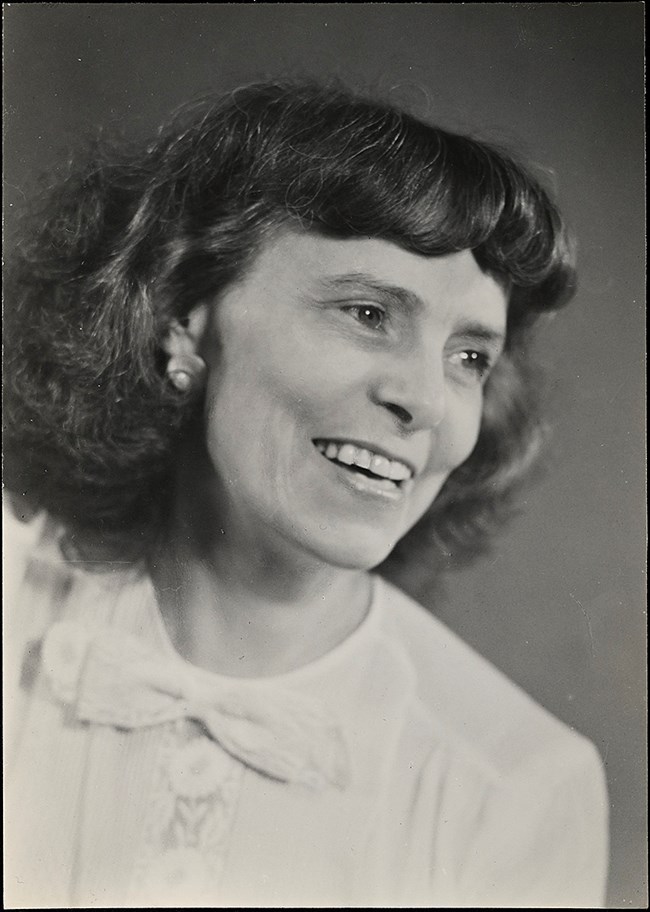
Dorothy Waugh was shy and afraid of people as a child. She graduated from George School, a Friends’ boarding school in Bucks County, Pennsylvania. Waugh studied at the Massachusetts School of Art, the Museum School of the Cleveland Museum of Art, Ecole des Beaux Arts d'Orleans, John Herron School of Art in Indianapolis, and Trenton School of Art. Possibly due to her father’s influence, she also studied landscape architecture at Massachusetts State College. She worked for landscape architects in Boston, Cleveland, New Orleans, and Charlotte, North Carolina.
Her father “wanted to make her more independent” and sent her to study at the Chicago Art Institute. She graduated with honors in 1928 when she was about 32 years old. She worked at a commercial art studio in Chicago for several years before moving to New York City to work as a freelance artist in 1932.
Waugh was hired by the NPS as a landscape architect and artist in the Branch of Planning around 1933. She had a family connection to the NPS. Her father mentored Conrad L. Wirth during his training as a landscape architect. Wirth would have been familiar with her artistic abilities and her landscape architecture work. Wirth became an NPS assistant director in 1931. He led the NPS Emergency Conservation Work programs in state parks (and later served as NPS director from 1951 to 1964).
Wirth hired Waugh to gather information on park facilities and develop an illustrated manual with instructions to construct basic park structures that could be used by the Civilian Conservation Corps (CCC). Waugh's designs provided practical prototypes that could be adapted or reproduced by CCC workers. Her illustrations can be seen in Portfolio of Comfort Stations and Privies (1934) and Portfolio of Park Structures (1935). The latter book lists her title as “landscape architect and artist, second region.”
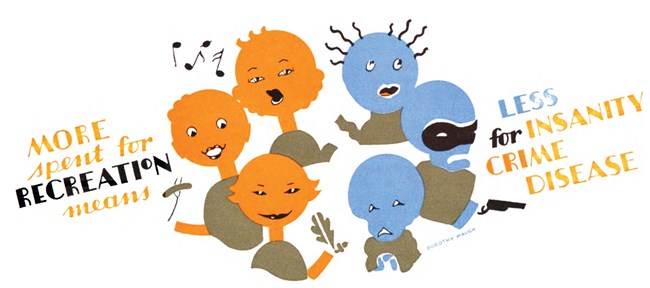
In 1934 the portfolio work gave way to a manual that used photographs, drawings, and plans to illustrate successful projects in national and state parks. Waugh became a member of an advisory committee to collect and recommend plans and designs of merit. Her ideas and research, but not her drawings, went into the new volume. Waugh did illustrate part of the NPS report Recreational Use of Land in the United States, Part XI of the Report on Land Planning, published in November 1934. The drawings reflect Waugh's unique style, iconic fonts, and direct messages.
She resigned from the NPS around April 1937.
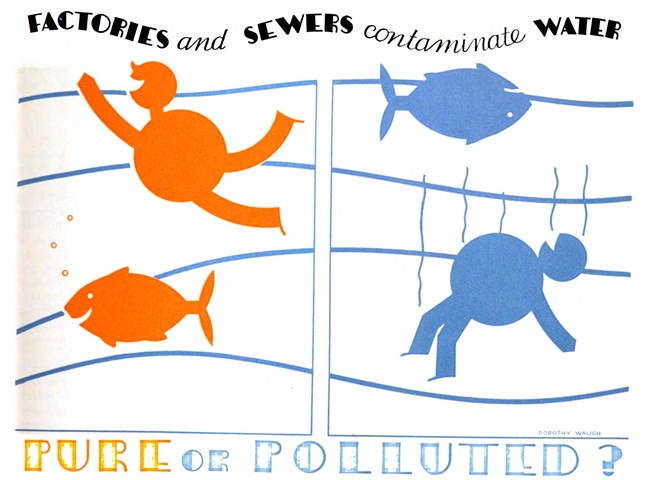
That same year she became the head of the children’s book department at Alfred A. Knopf, Inc., a position she held for about three years. In 1940 Waugh was hired as director of public relations for the Montclair Library in Montclair, New Jersey. In fall 1941, while still working at the library, she began teaching typography and production at Parsons School of Design in New York. The next year she was hired by the Cooper Union School of Art to teach “advanced advertising design for wartime service.” Waugh worked at the Montclair Library until April 1965, by which time she had added public relations specialist for the Office of Mayor to her resume as well.
Waugh illustrated and wrote several children’s books including Among the Leaves and Grasses (1932), Warm Earth (1942), and Muriel Saves String (1956). She also wrote A Handbook of Christmas Decorations (1958) and Festive Decorations for the Year Round (1961). Waugh illustrated over 50 other books for children and adults. Her poems and drawings appeared in dozens of magazines and newspapers. An expert on Emily Dickinson, Waugh’s book Emily Dickenson’s Beloved: A Surmise was published in 1976. She also hosted a radio interview show for seven years on WVNJ and worked on other radio and television programs.
Dorothy Waugh died March 20, 1996, aged 99 years.
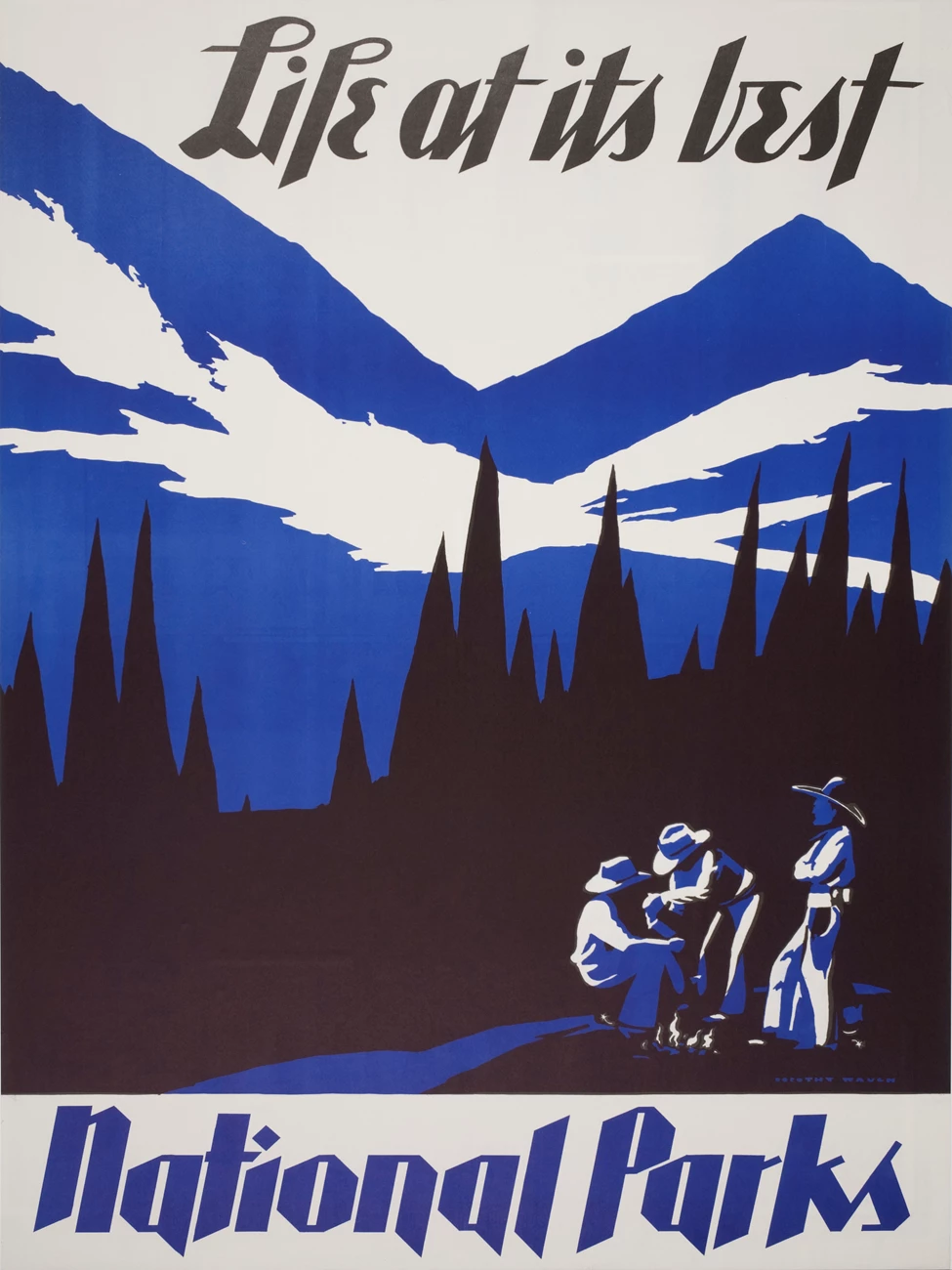
From Privies to Posters
It’s not known how Waugh’s NPS work evolved to include posters to promote state and national parks, but she picked up the task in 1934. Some sources indicate that she created her NPS posters while working for the Federal Art Project (FAP), but we can demonstrate that is not true. Not only was Waugh an NPS employee, but at least eleven of her posters were created before FAP was established on August 29, 1935.
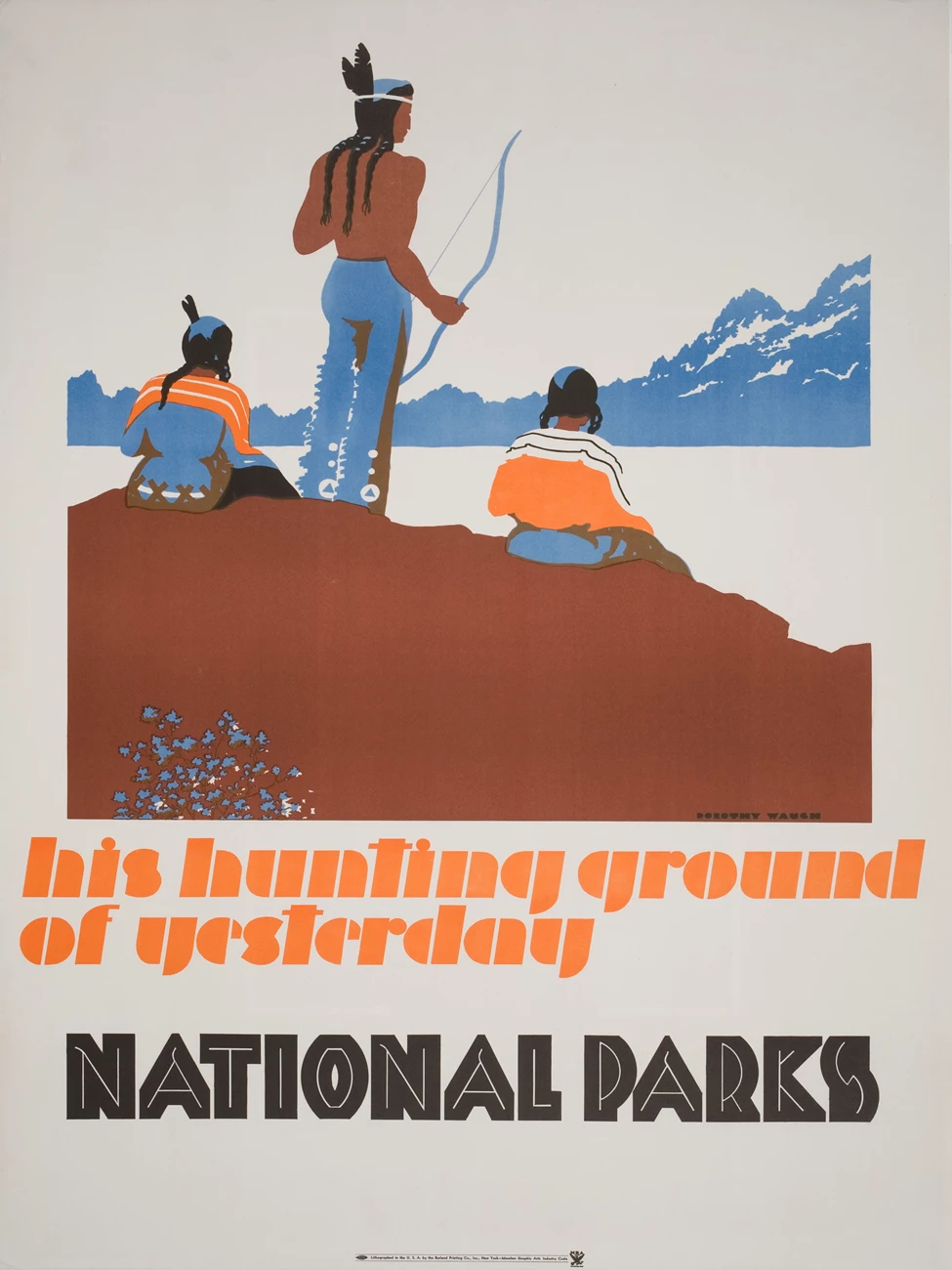
The August-September 1934 Park Bulletin newsletter ran an article with the headline “Colorful Park Posters Available.” It noted:
With the aid of State Park Emergency Conservation Work Funds, it has been possible for the Service to have printed for distribution to tour bureaus, railroads, schools, travel clubs, etc., a set of six colorful posters depicting national park scenes. Miss Dorothy Waugh, a New York artist, sketched the posters and they were printed by the Burland Printing Company of New York City under contract let by the Government Printing Office. United States citizens for many years have seen the Swiss Alps, the Italian Lake country, and other beauty spots of foreign lands depicted in beautiful posters on display throughout the land and it is time that Americans should be acquainted with their own beauty spots through the same medium.
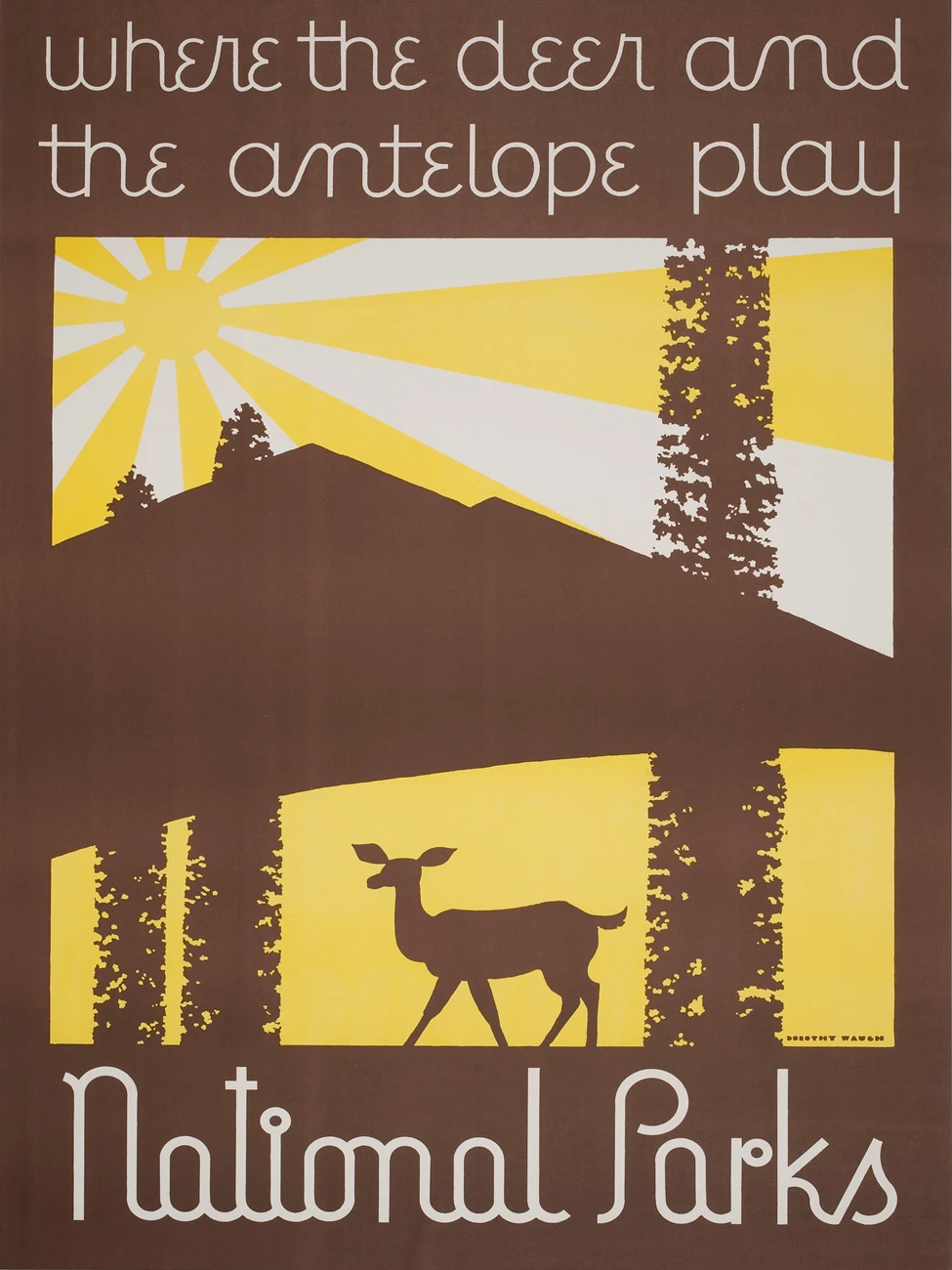
In his 1934 report to the secretary of the Interior, NPS Director Arno B. Cammerer references “the Federal campaign to make 1934 outstanding as a national park year.” It was declared National Parks Year and in January Secretary of the Interior Harold L. Ickes appealed to the American people to visit their national parks. The NPS launched a campaign to increase visitation, supported by concessions, railroads, automobile associations, oil companies, conservationists, and others. He notes several “extraordinary activities of the NPS in promoting park travel in 1934…including the preparation of six national park posters, the first to be issued by the Department of the Interior.”
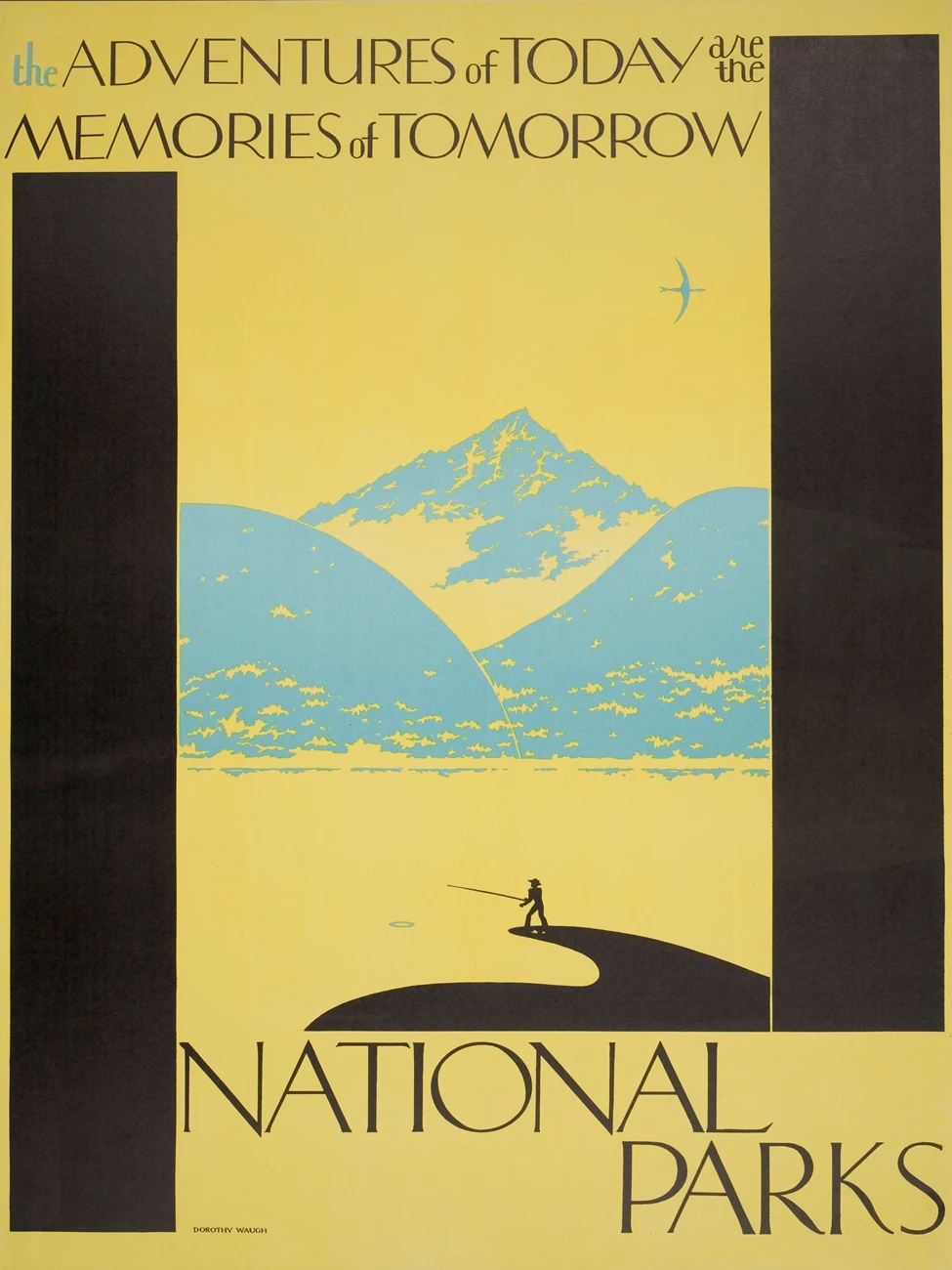
The annual report does not name Waugh as the artist behind the posters but there is no doubt that Cammerer is referring to her work. A September 8, 1934, article in The Chattanooga News further supports the Park Service Bulletin connection to Waugh, noting:
The historical division of the Chickamauga-Chattanooga National Military Park has received a number of posters advertising the national parks and will place them in local railroad and bus stations and hotels. The posters, by Dorothy Waugh, represent six scenes in the parks, showing healthful and carefree life there. H.C. Landru, historical historian [sic], said a national campaign is being undertaken to persuade the public to visit the parks. This is ‘National Park Year.’
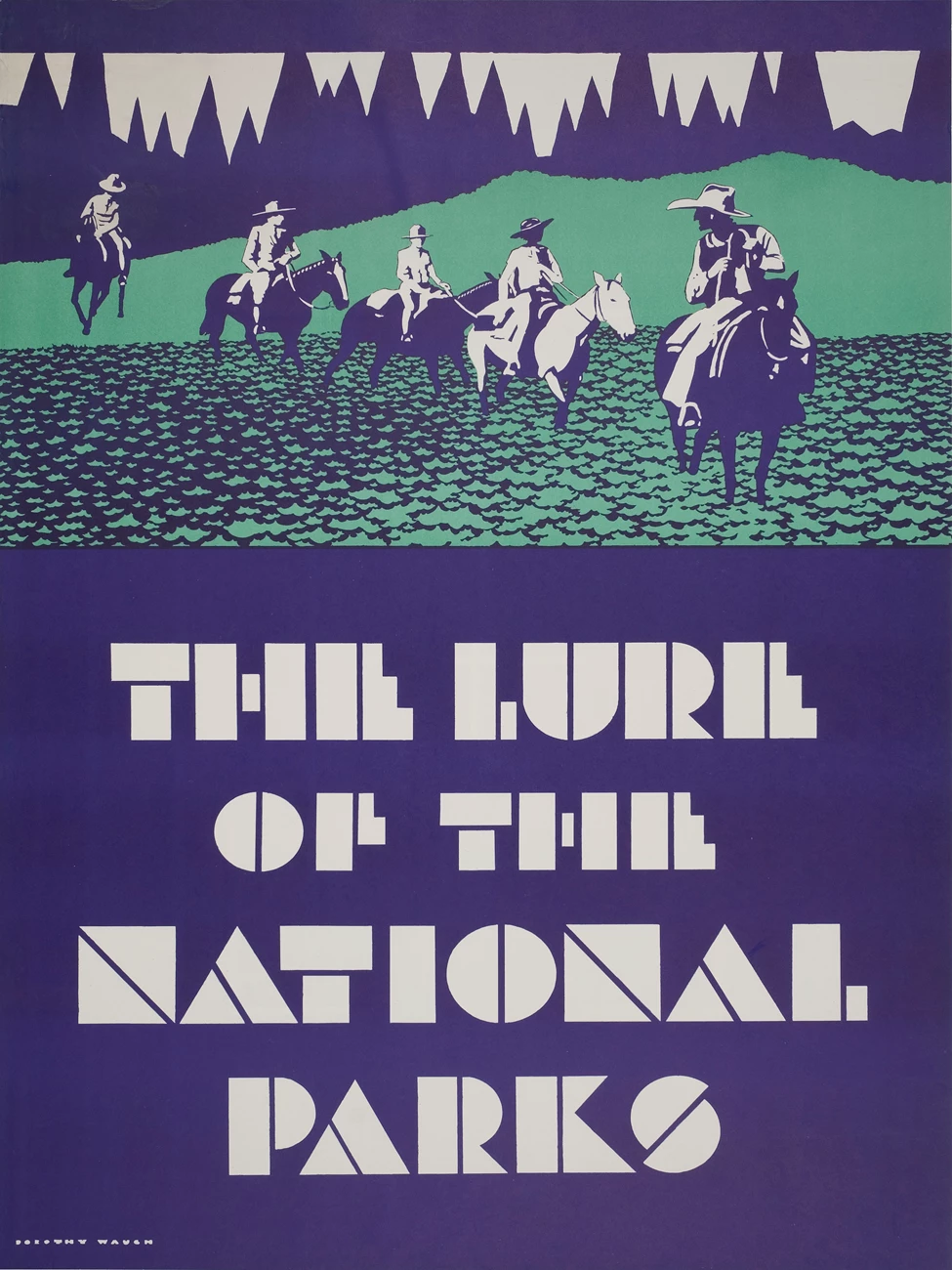
This evidence makes it clear that Waugh’s six national park posters, featured in this 50 Nifty Finds article and part of the NPS History Collection, were first printed in August 1934 to publicize the Year of National Parks.
We know, however, that Waugh created more than six designs for national and state parks. Cammerer’s 1935 annual report contains a section entitled, “Posters” which reads:
The first colored posters depicting national-park activities to be printed by the Department of the Interior were issued shortly after the close of the 1934 fiscal year. These were followed by 2 others stressing winter sport activities, and later by another series of 3 representing historic, prehistoric, and wildlife phases of national-park work. Only small editions of these various posters, financed from emergency funds, were possible. The demand for them, and their display in places prominent throughout the country, proved the desirability of the extension of this type of printing. Educational institutions showed a marked interest in the posters, using them in connection with art and geography classes, and for general display.
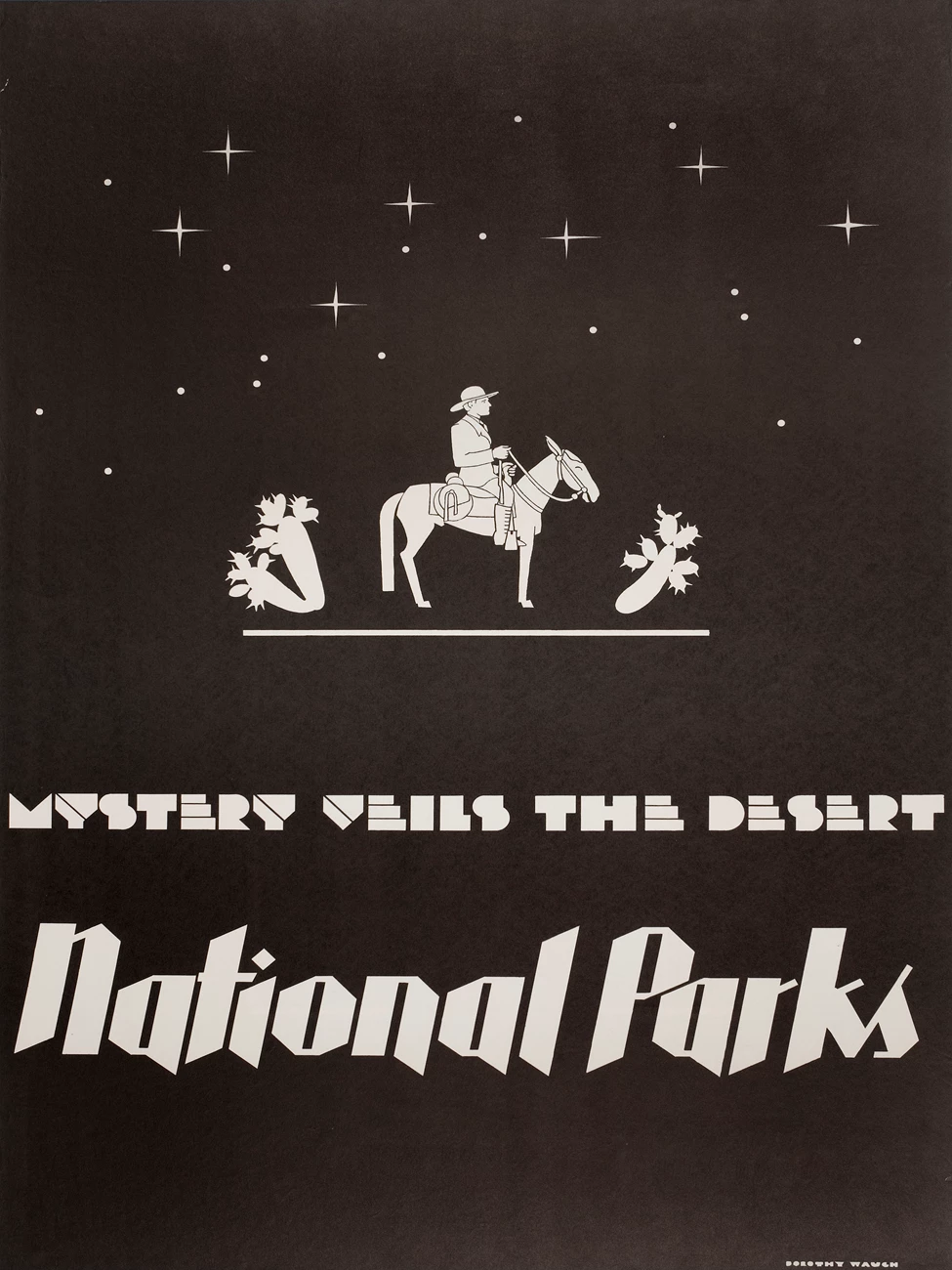
Waugh’s 1935 lithographs “National Parks Skiing” and “National Parks Winter Sports” were printed by the Columbia Planograph Company in Washington, DC. Waugh had begun sketching them by October 1934. The cultural resources posters in this 1935 series are “Pueblos of the Southwest National Parks & Monuments” and “Historic National Parks and Monuments.” Her “Save our Wild Life” poster was created in cooperation with the Biological Survey Bureau.

In addition to the 11 national park posters Cammerer refers to from 1934 and 1935, Waugh also created a series of posters for state parks or both state and national parks. Cammerer’s 1936 annual report states:
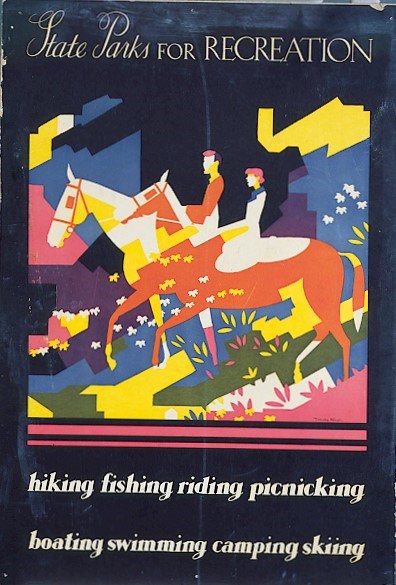
Five additional Waugh posters are accounted for but Cammerer’s report suggests that another existed, bringing the total to 17 rather than the 16 usually cited. Three posters are listed in the 1936 catalog of government publications: “State Parks” [for Picnics], “State Parks” [for Sports], and “State Parks for Recreation.” It seems likely that “Winter Sports National & State Parks” and “Skiing, Skating, Sliding, Sleighing National and State Parks,” were also created in 1936, although they are not listed in that year’s catalog. They are also not in the catalog covering the period from January 1937 to December 1938. In his 1934—1936 annual reports, Cammerer repeatedly notes that funding was an issue and printing was limited. Unfortunately, he never includes how many of each poster was printed.
Spreading the Gospel of National Parks
When Waugh resigned from the NPS in spring 1937, the Park Service Bulletin article announcing her resignation also noted that she drew national and state park stickers. They were released in 1936 as a "new type of advertising for park areas." The November 1936 Park Service Bulletin reported:
50 colorful envelope stickers—35 national park and 15 state park—depicting scenes and activities in these areas, have been issued by the Service and will undoubtedly arouse widespread interest in these ideal vacationing spots. The greater portion of these stickers has been forwarded to the field for distribution to local organizations interested in the work of the Service. Dorothy Waugh, the New York artist who drew the designs for all the national and state park posters issued thus far by the Service, prepared the sketches for the stickers, which were printed by an offset color process by Columbia Planograph Company of Washington, DC. They were all 1 3/4" by 2 3/8" in size.
The total number of stickers printed is unknown. However, they were still being used two years later when the Park Service Bulletin ran a story titled, "Stickers Used to Designate Locations of Parks." The article relates the use of Waugh's stickers on a giant map of the United States to show "the geographic positions of the parks." It was on display at the Cincinnati Public Library in Ohio. The article notes, "Designed by Dorothy Waugh, these stickers were issued for use on correspondence where they would serve to spread the gospel of national parks."
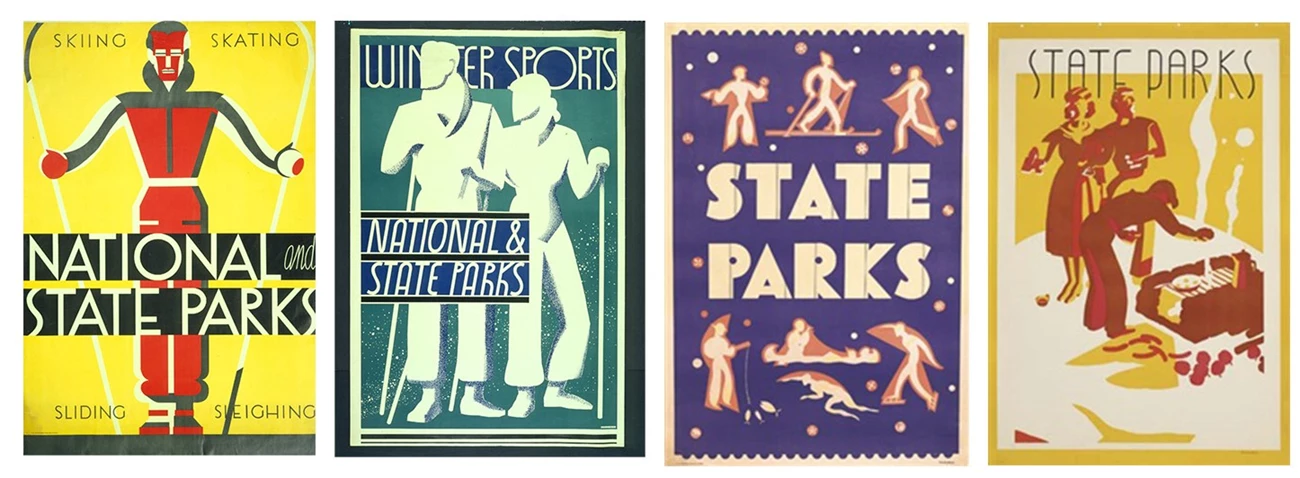
An Expanded Poster Program
In the late 1930s and early 1940s, new posters were created to publicize the parks and NPS messaging. From 1938 to 1941, WPA and CCC artists working at the NPS Western Museum Laboratory (WML) in Berkeley, California, designed a series of silk screened posters to advertise the ranger naturalist program and interpretive opportunities at Yellowstone (with two posters), Yosemite, Glacier, Zion, Grand Canyon, Grand Teton, Mount Rainier, Wind Cave, Lassen Volcanic, Great Smoky Mountains, and Rocky Mountain national parks and Bandelier, Petrified Forest, Saguaro, and Fort Marion (now Castillo de San Marcos) national monuments. Other WML silkscreen posters warned of fire danger, enhanced safety messages, and urged protected native species.
The United States Travel Bureau, tasked with encouraging travel within the United States (and part of the NPS for a period of time), worked with the WPA Federal Arts Project NYC to create new silk screened posters. The NPS United States Travel Bureau's New York office released two "attractive colored posters" with the slogan "See America—Welcome to Montana” in November or December 1938. The artist was Martin Weitzman. “See America” by Alexander Dux was released in 1939 and “See America Visit National Parks” in 1940. The WPA Federal Arts Project NYC also created at least four posters encouraging protection of wildlife. In 1939 J. Hirt designed “The National Parks Preserve Wildlife” featuring two bighorn sheep. Also around 1939 "Stay a Safe Distance Do Not Feed the Bears", attributed to Charles Verschruren, was also printed. That poster from the NPS History Collection can be seen in 50 Nifty Find #46: Feeding the Habit. In 1940 Frank Nicholson designed “Wild Life,” and John Wagner designed “Don’t Kill Our Wild Life."
Although these later posters, particularly the WML park posters, have received more attention in recent years, it was Waugh’s iconic designs that established the interest and value in an NPS poster program as a tool for promoting national parks.
Sources:
--“Advertises Park.” (1934, September 8). The Chattanooga News (Chattanooga, Tennessee), pg. 14.--“Children’s Book by Dorothy Waugh Accepted by New York Publishers.” (1955, May 5). The Montclair Times (Montclair, New Jersey), pg. 26.
--“Glen Ridge Contest Judges Announced.” (1946, February 28). The Montclair Times (Montclair, New Jersey), pg. 21.
--“Joins Cooper Union Faculty.” (1942, August 27). The Montclair Times (Montclair, New Jersey), pg. 18.
--"Library Aid to Leave Post.” (1965, April 8). The Montclair Times (Montclair, New Jersey), pg. 4.
--“’Spieleris’ Started Her.” (1956, March 22). Verona-Cedar Grove Times (Verona, New Jersey), pg. 25.
Kcrmarik, Katie. (2021). “Women of the Federal Art Project Poster Division” accessed 12/23/2022 at https://journalism.unl.edu/pdf/katie-design.pdf
Maurice, Maggie. (1977, July 21). “She Loves the Town She Hasn’t Seen in 50 Years.” The Burlington Free Press (Burlington, Vermont), p. 25.
McClelland, Linda Flint. (1993). Presenting Nature: The Historic Landscape Design of the National Park Service, 1916 to 1942. National Park Service.
National Park Service. (1934, August-September). “Colorful Park Posters Available.” Park Service Bulletin, Vol 4, No 5, p.16. (NPS History Collection, HFCA 1645)
National Park Service. (1934, October). "More Posters to be Printed." Park Service Bulletin, Vol 4, No 6, p.24. (NPS History Collection, HFCA 1645)
National Park Service. (1935). Park Structures and Facilities. NPS Branch of Planning.
National Park Service. (1936, November). "New Type of Advertising for Park Areas." Park Service Bulletin, Vol 6, No. 9, p. 6. (NPS History Collection, HFCA 1645)
National Park Service. (1937, April-May). “About Folks.” Park Service Bulletin, Vol 7, No 4, p. 39. (NPS History Collection, HFCA 1645)
National Park Service. (1938, July). “Stickers Used to Designate Locations of Parks.” Park Service Bulletin, Vol 8, No 5, p. 7. (NPS History Collection, HFCA 1645)
National Park Service. (1938, November-December). “See America Welcome to Montana.” Park Service Bulletin, Vol 8, No 8, p. 24. (NPS History Collection, HFCA 1645)
Richman-Abdou, Kelly (2020, June 8). “Learn How the ‘Federal Arts Project’ Gave American Artists Hope During the Great Depression.” Accessed 12/23/2022 at https://mymodernmet.com/wpa-federal-art-project/
United States Department of the Interior. (1934). Annual Report of the Department of the Interior. US Government Printing Office, Washington, DC. (NPS History Collection, HFCA 1645)
United States Department of the Interior. (1935). Annual Report of the Department of the Interior. US Government Printing Office, Washington, DC. (NPS History Collection, HFCA 1645)
United States Department of the Interior. (1936). Annual Report of the Department of the Interior. US Government Printing Office, Washington, DC. (NPS History Collection, HFCA 1645)
Unites States Superintendent of Documents. (1936). Catalogue of the Public Documents of the Congress and All Departments of the Government of the United States for the Period from January 1935-December 1936. Washington, DC.
